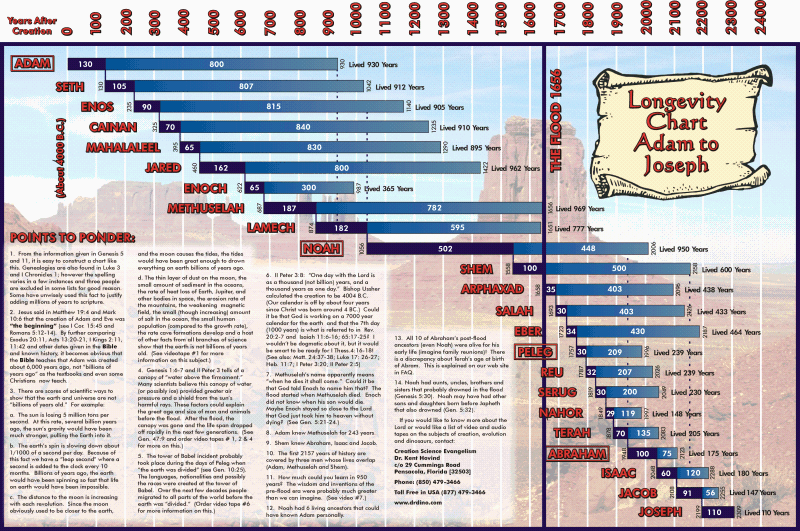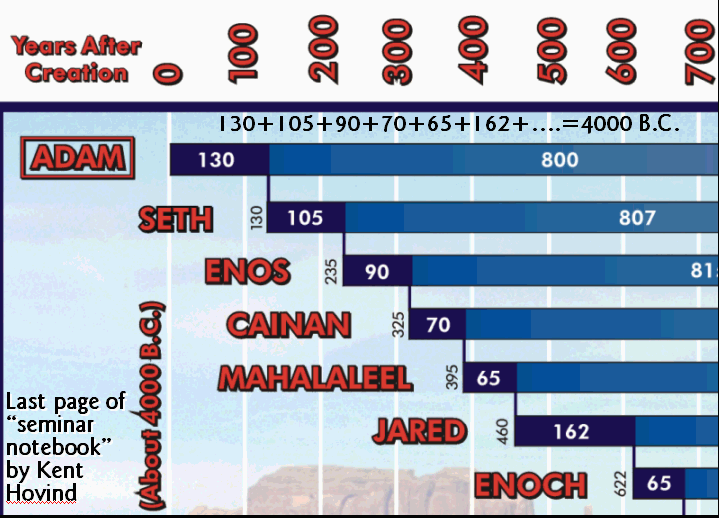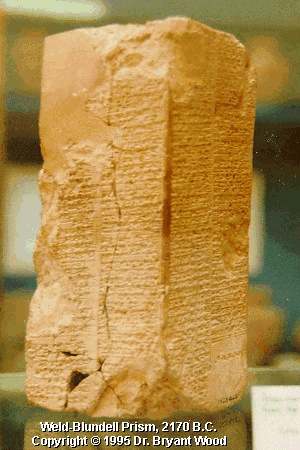
How Old is the Human Race?
The Genealogies of Genesis 5 and 11
|
|
| Taken from last page of “seminar notebook” by Kent Hovind |
By adding up the age the years in the genealogies of Genesis 5 and 11 we can determine the number of years from the creation of Adam to the birth of Abraham as about 2000 years. Since there is almost universal agreement that Abraham lived around 2000 B.C., then we see that the Bible teaches that the human race was created around 4000 B.C. and is therefore about 6000 years old.
Note the wording of the text of Genesis 5:
Genesis 5:1-32 - This is the written account of Adam's line. When God created man, he made him in the likeness of God. 2 He created them male and female and blessed them. And when they were created, he called them "man."
3 When Adam had lived 130 years, he had a son in his own likeness, in his own image; and he named him Seth. 4 After Seth was born, Adam lived 800 years and had other sons and daughters. 5 Altogether, Adam lived 930 years, and then he died.
6 When Seth had lived 105 years, he became the father of Enosh. 7 And after he became the father of Enosh, Seth lived 807 years and had other sons and daughters. 8 Altogether, Seth lived 912 years, and then he died.
9 When Enosh had lived 90 years, he became the father of Kenan. 10 And after he became the father of Kenan, Enosh lived 815 years and had other sons and daughters. 11 Altogether, Enosh lived 905 years, and then he died. . .
The text continues to follow the same pattern of naming each of the patriarchs and citing the patriarch's age at the time he became the father of the next patriarch, and so on through Noah and his sons:
Kenan. . . Mahalalel. . . Jared . . . Enoch . . . Methuselah. . . Lamech . . .Noah . . . 32 After Noah was 500 years old, he became the father of Shem, Ham and Japheth.
In Genesis 11, the text picks up with the genealogy of Shem (Noah's son) and continues though Abraham. In each case, the patriarch's age is given at the birth of his son:
Genesis 11:10-26 - Two years after the flood, when Shem was 100 years old, he became the father of Arphaxad. 11 And after he became the father of Arphaxad, Shem lived 500 years and had other sons and daughters.
12 When Arphaxad had lived 35 years, he became the father of Shelah. 13 And after he became the father of Shelah, Arphaxad lived 403 years and had other sons and daughters. . .
Shelah . . .
Eber
. . . Peleg
. . . Reu
. . . Serug
. . . Nahor
. . . Terah
. . . 26
After Terah had
lived 70 years, he became the father of Abram, Nahor and Haran.
So, again, determining the number of years
from Adam to Abraham is as simple as adding up the ages of each of the
patriarchs at the birth of their son and then counting backwards from the birth
of Abraham which nearly all scholars agree was around 2000 B.C.
 |
Archbishop James Ussher of Armagh (1581-1656)
 |
Archbishop Ussher’s Chronology of the Bible
• Was originally compiled in 1650.
• Was based on a literal interpretation of the genealogies of Genesis 5 and 11 in addition to other Biblical and historical data.
• Gave a date of 4004 BC for the creation of the heavens and the earth and a date of 2348 BC for Noah's flood.
• Was printed in the margins of the King James Bible for many years, beginning in the eighteenth century.
• Is often criticized today for:
– Attempting to be too precise
– Interpreting the Bible too literally
– Giving too young a date for the creation
Genealogical Data -- Genesis 5
|
Verses in Genesis |
Father – Son(s) |
Age at Son’s Birth |
Years From Creation |
Ussher Date(BC) |
Age at Death |
|
1:26-27; 2:7 |
Creation of Adam |
|
0 |
4004 |
|
|
5:3-5 |
Adam - Seth |
130 |
130 |
3874 |
930 |
|
5:6-8 |
Seth - Enos |
105 |
235 |
3769 |
912 |
|
5:9-11 |
Enos - Cainan |
90 |
325 |
3679 |
905 |
|
5:12-14 |
Cainan - Mahaleel |
70 |
395 |
3609 |
910 |
|
5:15-17 |
Mahaleel - Jared |
65 |
460 |
3544 |
895 |
|
5:18-20 |
Jared - Enoch |
162 |
622 |
3382 |
962 |
|
5:21-24 |
Enoch - Methusalah |
65 |
687 |
3317 |
365 |
|
5:25-27 |
Methusalah - Lamech |
187 |
874 |
3130 |
969 |
|
5:28-31 |
Lamech - Noah |
182 |
1056 |
2948 |
777 |
|
5:32; 9:29 |
Noah - Shem, Ham, & Japheth |
500 |
1556 |
2448 |
950 |
|
7:6 |
Flood (Noah age 600) |
|
1656 |
2348 |
|
Genealogical Data -- Genesis 11
|
Verses in Genesis |
Father – Son(s) |
Age at Son’s Birth |
Years From Creation |
Ussher Date (BC) |
Age at Death |
|
11:10-11 |
Shem - Arphaxad |
100 |
1656 |
2348 |
600 |
|
11:12-13 |
Arphaxad - Salah |
35 |
1691 |
2313 |
438 |
|
11:14-15 |
Salah - Eber |
30 |
1721 |
2283 |
433 |
|
11:16-17 |
Eber - Peleg |
34 |
1755 |
2249 |
463 |
|
11:18-19 |
Peleg - Reu |
30 |
1785 |
2219 |
239 |
|
11:20-21 |
Reu - Serug |
32 |
1817 |
2187 |
249 |
|
11:22-23 |
Serug - Nahor |
30 |
1847 |
2157 |
230 |
|
11:24-25 |
Nahor - Terah |
29 |
1876 |
2128 |
148 |
|
11:26 |
Terah - Abram, Nahor, & Haran |
70 |
1946 |
2058 |
205 |
Should We Opt for a Strict Literal Interpretation of the Genealogies (of Genesis 5 and 11)?
Secular Objections to Opting for a Strict Interpretation of the Genealogies of Genesis 5 and 11:• Secular Objections:
– Archeologists claim to have found civilizations preceding Ussher's Date for Creation.
– Archeologists claim to have found civilizations existing during Ussher's date for the Flood
• Some Things to Think About:
– Archeology is far from being a precise science.
– Archeological dating methods are far from certain.
Note: Archeologists have often claimed that the Bible was wrong, only to discover later that the Bible was right after all. To name just a few examples:
• Nelson Glueck, famous Jewish archaeologist, spoke of what he called ‘the almost incredibly accurate historical memory of the Bible, and particularly so when it is fortified by archaeological fact.’ (Geisler, N.L. and Nix, W.E., A General Introduction to the Bible, Moody Press, Chicago, 1986)
• William F. Albright, widely recognized as one of the great archaeologists, stated:
– ‘The excessive skepticism shown toward the Bible by important historical schools of the eighteenth and nineteenth centuries, certain phases of which still appear periodically, has been progressively discredited. Discovery after discovery has established the accuracy of innumerable details, and has brought increased recognition to the value of the Bible as a source of history.’ (McDowell, J., Evidence that Demands a Verdict, Vol. 1, Campus Crusade for Christ, San Bernadino, CA, 1972 )
• The Hittites were once thought to be a Biblical legend, until their capital and records were discovered at Bogazkoy, Turkey.
• Many thought the Biblical references to Solomon's wealth were greatly exaggerated. Recovered records from the past show that wealth in antiquity was concentrated with the king and Solomon's prosperity was entirely feasible.*
• It was once claimed there was no Assyrian king named Sargon as recorded in Isaiah 20:1, because this name was not known in any other record. Then, Sargon's palace was discovered in Khorsabad, Iraq. The very event mentioned in Isaiah 20, his capture of Ashdod, was recorded on the palace walls. What is more, fragments of a stela memorializing the victory were found at Ashdod itself.*
• Another king who was in doubt was Belshazzar, king of Babylon, named in Daniel 5. The last king of Babylon was Nabonidus according to recorded history. Tablets were found showing that Belshazzar was Nabonidus' son who served as coregent in Babylon.*
• *Examples cited from http://www.christiananswers.net/q-abr/abr-a008.html
Another Secular Objection to Opting for a Strict Interpretation of the Genealogies of Genesis 5 and 11:
• Secular Objection:
– The genealogies of other ancient cultures seem to suggest that those civilizations existed for more time than a literal interpretation of Genesis 5 and 11 would allow.
• Something to Think About:
– When faced with an irreconcilable conflict between the genealogies in the Bible and the genealogies of ancient heathen nations, which would you believe?
Examples of Ancient Pagan Chronologies (From Halley’s Bible Handbook, 1965 edition, p.71):
 |
Berosus
• According to Berosus, these kings (supposedly) reigned from 10,000 to 60,000 years each!
Weld Prism and Nippur Tablets
Ancient pagan inscriptions uncovered in recent times, such as the Weld Prism and Nippur Tablets, give a similar list to the one recorded by Berosus. The kings given in these inscriptions are listed below:
Chronology of Kings Given in the Weld Prism and Nippur Tablets: Alulim Reigned at Eridu 28,000 years Alalmar Reigned at Eridu 36,000 years Emenluanna Reigned at Badgurgurru 43,000 years Kichunna Reigned at Larsa 43,000 years Enmengalanna Reigned at Badgurgurru 28,000 years Dumuzi Reigned at Badgurgurru 36,000 years Sibzianna Reigned at Larak 28,000 years Emenduranna Reigned at Sippar 21,000 years Uburratum Reigned at Shuruppak 18,000 years Zinsuddu (Utnapishtim) 64,000 years “Then the Flood overthrew the land.”
• It seems that the ancient pagans tended to exaggerate when giving the chronologies of their ancient ancestors!
• But, although they tended to exaggerate, it is interesting that the Babylonians, Egyptians, Hindus, Greeks and others all record that the earth’s earliest inhabitants lived for long periods of time.
• This undoubtedly is because men in ancient times did in fact live for long periods of time.
Supposed Biblical Objection Against Opting for a Strict Interpretation of the Genealogies of Genesis 5 and 11:
• Supposed Biblical Objection:
• Some Christians believe that there could be "gaps" (missing names) in the genealogies of Genesis 5 and 11 because:
• In the Bible, “became the father of” can mean to become “the ancestor of”, rather than “the immediate father of” someone. We see an example of this in the genealogy of Matthew 1:8 where it says that Jehoram was the father of Uzziah. But we know from 2 Kings 8:25, 11:2, 14:1, and 2 Chronicles 26:1 that Jehoram was actually the great-great-grandfather of Uzziah!
• Genesis 11:12 tells us that Arphaxad became the father of Shelah whereas Luke 3:35-36 tells us that Arphaxad was the grandfather of Shelah (Cainan is listed as his son).
• Some Things to Think About:
• It is important to note that Biblical inerrancy, derived from the teaching that Scripture is ‘God-breathed’ (2Tim. 3:15-17, cf. 2Pet. 1:20-21) and ‘cannot be broken’ (John 10:35), has to refer to the original autographs that God directly inspired, not to copies or translations.
• A good case can be made that the name “Cainan” found in Luke but not in Genesis is one of the extremely few copyist’s errors in the manuscripts available today. (http://www.answersingenesis.org/docs/3748.asp)
• If this is the case, then there is no “gap” in the genealogy of Genesis 11:12 as some claim.
• Unlike the chronologies of Matthew and Luke, Genesis 5 and 11 gives each patriarch's age at the birth of his son.
• If the each age given is the patriarch's age at the birth of the descendant listed, then we can still add the years listed to arrive at a date for Adam's creation (even if there are "gaps").
• What would be the purpose of listing each patriarch's age at the birth of his descendant if it is not for establishing an accurate chronology of early human history?
How Old is the Human Race?
If we interpret the genealogies in a straightforward, literal manner then the human race is about 6000 years old:
| From Adam to the Abraham: | 2,000 years | |
| From Abraham to Christ: | 2,000 years | |
| From Christ to the Present: | 2,000 years | |
| Age of the Human Race: |
6,000 years |